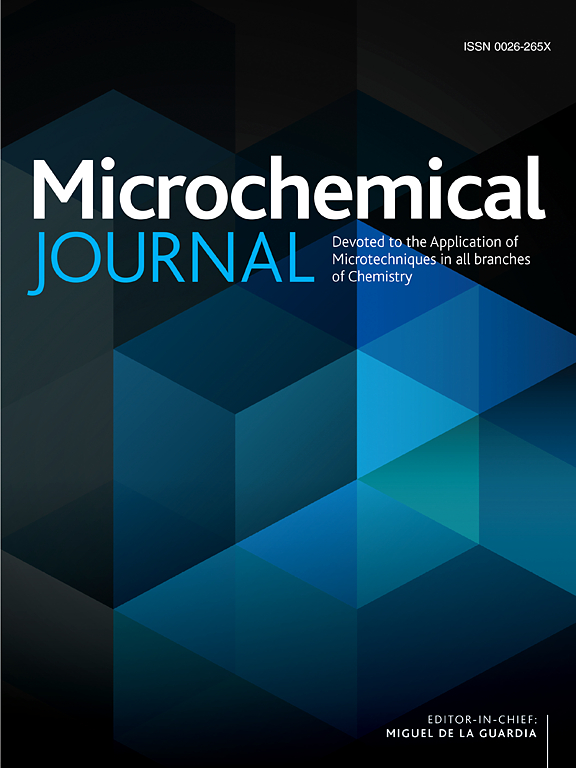氮和硫掺杂石墨烯量子点作为一种基于荧光纸的传感器,用于高选择性和敏感地检测水样品中的汞离子
IF 4.9
2区 化学
Q1 CHEMISTRY, ANALYTICAL
引用次数: 0
摘要
汞离子(Hg2+)是食品工业和环境中的有毒污染物,构成严重的健康风险,包括水俣病。食品和环境样品中Hg2+的快速可靠的现场检测方法至关重要。本研究提出了氮和硫掺杂的石墨烯量子点(N, S-GQDs)作为检测Hg2+的荧光传感器。通过快速加热,柠檬酸和l -半胱氨酸在5 min内合成了N, S-GQDs。通过傅里叶变换红外光谱(FT-IR)、x射线光电子能谱(XPS)和x射线吸收光谱(XAS)技术,鉴定了羧基、羟基、硫醇和胺基以及特定的元素组成。这些分析证实了氮和硫成功掺杂到GQD框架中,并突出了它们与Hg2+离子的强相互作用能力。该传感器具有较高的选择性和灵敏度,线性范围为0.1 ~ 10.0 μg/L,检出限为0.048 μg/L,对Hg2+有较强的荧光响应。在实际水和食品样品中的测试进一步验证了其有效性,所得结果与电感耦合等离子体光学发射光谱(ICP-OES)验证结果一致。此外,该传感器对12种金属阳离子和6种阴离子的Hg2+具有很高的选择性。这些基于纸张的传感器,用多环芳烃(PAHs)修饰,具有成本效益、可生物降解、生物相容性和环境友好性,因为纸张材料丰富。多环芳烃减小了纸张的孔径,促进了多环芳烃的六边形环与N, S-GQDs的石墨烯片之间的π-π堆积相互作用。这改善了粒子的分散,最大限度地减少了聚集,并有助于维持N, S-GQDs的荧光稳定性。因此,在水和食物中痕量Hg2+的实际分析中具有很大的应用前景。本文章由计算机程序翻译,如有差异,请以英文原文为准。

Nitrogen and sulfur doped graphene quantum dots as a fluorometric paper-based sensor for highly selective and sensitive detection of mercury ions in aqueous samples
Mercury ions (Hg2+) are toxic contaminants in the food industry and environment, posing severe health risks, including Minamata disease. Rapid and reliable on-site detection methods for Hg2+ in food and environmental samples are crucial. This study presents nitrogen and sulfur doped graphene quantum dots (N, S-GQDs) as fluorescent sensors for the detection of Hg2+. The N, S-GQDs were synthesized in only 5 min from citric acid and L-cysteine through rapid heating. The identification of carboxyl, hydroxyl, thiol, and amine groups, along with specific elemental compositions, was achieved through Fourier transform infrared spectroscopy (FT-IR), X-ray photoelectron spectroscopy (XPS), and X-ray absorption spectroscopy (XAS) techniques. These analyses verified the successful doping of nitrogen and sulfur into the GQD framework and highlighted their strong interaction capabilities with Hg2+ ions. The paper-based sensor exhibits high selectivity and sensitivity, with a linear range of 0.1–10.0 μg/L and a limit of detection of 0.048 μg/L, yielding strong fluorescence responses to Hg2+. Testing in real water and food samples further validates its effectiveness, yielding results consistent with those obtained using inductively coupled plasma optical emission spectroscopy (ICP-OES) validation. Furthermore, the sensor demonstrated high selectivity for Hg2+ over twelve metal cations and six anions. These paper-based sensors, modified with polycyclic aromatic hydrocarbons (PAHs), are cost-effective, biodegradable, biocompatible, and environmentally friendly due to the abundance of paper material. PAHs reduce the paper's pore size and facilitate π-π stacking interactions between the hexagonal rings of PAHs and the graphene sheet of N, S-GQDs. This improves particle dispersion, minimizes aggregation, and helps maintain the fluorescence stability of N, S-GQDs. Therefore, it is highly promising for practical trace Hg2+ analysis in water and food.
求助全文
通过发布文献求助,成功后即可免费获取论文全文。
去求助
来源期刊

Microchemical Journal
化学-分析化学
CiteScore
8.70
自引率
8.30%
发文量
1131
审稿时长
1.9 months
期刊介绍:
The Microchemical Journal is a peer reviewed journal devoted to all aspects and phases of analytical chemistry and chemical analysis. The Microchemical Journal publishes articles which are at the forefront of modern analytical chemistry and cover innovations in the techniques to the finest possible limits. This includes fundamental aspects, instrumentation, new developments, innovative and novel methods and applications including environmental and clinical field.
Traditional classical analytical methods such as spectrophotometry and titrimetry as well as established instrumentation methods such as flame and graphite furnace atomic absorption spectrometry, gas chromatography, and modified glassy or carbon electrode electrochemical methods will be considered, provided they show significant improvements and novelty compared to the established methods.
 求助内容:
求助内容: 应助结果提醒方式:
应助结果提醒方式:


